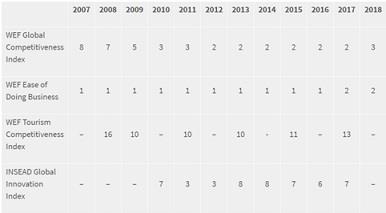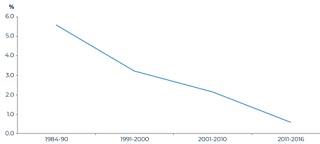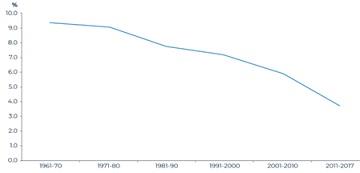Labour Management Relations
DON'T MISS YOUR CHANCE TO EXCEL IN MANAGEMENT ASSIGNMENT! HIRE TUTOR OF EXPERTSMINDS.COM FOR PERFECTLY WRITTEN LABOR MANAGEMENT RELATIONS ASSIGNMENT SOLUTIONS!
1) Introduction of labour management relations (LMR) - 300 words.
Answer: The purpose of the literature is to explore the concept of Labor management relations. It is the system that comprises of the set of rules and policies that govern and organize employment mechanisms in a business environment(Razi & Ramzan, 2012). With the increasingly competitive environment where pressures to excel are exceeding it has become essential more than ever to acquire effective labor relations support programs. This can be done by applying well defined enterprise procedures that not only matches well with the interest of employees and employers but also involves strategic human resource policies to work at national and local level thus helping businesses to better plan their day to day processes and working for better delivery of their products and services. Labor management relations are composed of three elements; problem solving, ethical and science building. In all three phases, Labor management relations prepare the employees to improve analytically by building creative skills through improvement schemes while prepare industries to design policies and principles that work in favor of both labor force and management in an ethical way which will automatically lead both to advancement.
a. Describe Singapore industrial relations
b. Describe scope
Answer: With respect to understanding the concept of industrial relations in Singapore, a well-accepted framework by Dunlop (in 1958's) can be used. The Dunlop model comprises of three main actors that is management, union and government and suggests the creation of an environment in which all three actors interact in a positive manner for the greater good of the society. With the aim to break into global markets, companies are shifting to adopting intensive labor manufacturing production theme that have started pressurizing the labor force leading them to demand rise in their living standard, improved wages and employee friendly policies. World trade organization has come out as a labor representative body by allowing the trade sanctions against those countries whose governments do no observe accepted labor standards. This action has also made most of the government conscious of their role towards the labor management (Kaur, 2004). According to Singapore LHR model, a unique affiliation seemed to reflect from all three parties that is employers, government and unions also known as Tripartism with the scope to promote conflict free working culture with strong relations among management with workers, financial improvement and economic growth creating optimistic atmosphere for investors to come in and invest in the country leading to the uplift of the nation as a whole. With the institutions such as National wage council wage guidelines were set up to endorse not only order but also encourage social development by installing incentives to cultivate a cohesive yet progressive society.
2) Analysis on roles of 4 key players of LMR - 800 words
Answer: In today's extremely changing economic scenarios of the world to cater the intensely challenging business environment it has become important for the company to invest in productive labor relations through involving all four key players including unions, management, government and employees to work together as partners providing amicable solutions to the emerging problems. There are four key players of LMR as discussed one by one.
a. Government roles (Ministry of manpower)
Answer: Government serves as the main supervisory body that can put a check on both the employers and unions to work under laws that must take into account the interest of all the members working for the organizations. The laws of the government serve as an accountability benchmark that might assist in prohibiting the employers from treating employees unfairly out of any reasons such as color, origin, race or creed(Mayhew, 2018).Governments make sure unions also follow provisions that prohibit them from entering into any secret agreements with the company preventing them to discriminate against non-members and those who do not have voice of their own. In Singapore, government body "Ministry of Manpower" act as a key player in managing and administering employment relations and providing assistance in the settlement of disputes along with participating as an active tripartite member.
b. Union (NTUC union)
Answer: Unions serve as the mediator between the management and labor. They act as a unified team of labor force and place their concerns in front of the authorities to let them know what they feel about working for the organization and how they should be treated. Unions work proactively towards collective bargaining and help the management to understand that whether employer's policies match with the expectations of employees or not. If not then there will be call for improvement at the managerial level to remove the existing gaps leading to increase the satisfaction level of workforce. With reference to Singapore, NTUC (the national trade union congress) is the representative body of trade unions which involves the network of professional associates and partners from all across the country. The objectives of NTUC are straightforward that is helping Singapore companies to stay competitive by empowering workers, enhancing their social status and wellbeing by treating them as the big part of the organization capable to bring productive changes(Nathan, 2016). It serves as the heart of the Singapore Labor movement hat strive to help every type of working class of all ages, nationalities and collars to achieve equal employment rights and justified wages for a quality living.
SAVE YOUR HIGHER GRADE WITH ACQUIRING LABOR MANAGEMENT RELATIONS ASSIGNMENT HELP AND QUALITY HOMEWORK WRITING SERVICES OF EXPERTSMINDS.COM!
c. Employers(Managment) (SNEF)
Answer: In the presence of increasingly deteriorating and conflicting relations between the employees and the organization due to harsh working schedules and environment, an overall productivity of organization gets highly affected. In spite of legal bills distrust among labors and management exists which can greatly hamper the performance of the business if policies are not set in favor of labor force(Prachi Juneja, 2015). In this regards, the role of HR consultant as a management representatives that serves as an impetus in driving the relationship of labors with their organization. This is done through conducting different programs that cater to the specific needs of the organization and labors both such as facilitation workshops, training activities and joint sessions thus improving labor-employer relations. In Singapore, the major employer organizations that communicate with union federation at local or national level involve Singapore international chamber of Commerce (SICC), Singapore business and manufacture's federations (SBF)/(SMF) and Singapore National employer federation who negotiate with unions and government bodies on bringing wage reforms, overlooking the role of women in employment, making decisions regarding expatriate workers and bringing policies that lead to motivation of workers for higher productivity.
d. Employees
Answer: With respect to employees there has to be an unbiased approach installed within the culture that foster clear and effective communication platform for all the concerned parties involved in business development process. Providing the employees with a progressive environment with good wages will automatically direct their focus to inducing better quality in their work. According to (Collings, 2009), employees have the potential to show faithfulness towards organizations and generate desired outcomes when they realize that their supervisory teams are constantly aware of their concerns, take immediate actions to resolve them and keep them under close discussions helping them to achieve up to their capacity. In this way, workers start experiencing healthy affiliations with their companies and feel motivated to work at their finest. For improved efficiencies it is crucial to maintain the contentedness of workers which can only be achieved through "management by objectives" providing them with better opportunities to grow and by encouraging their efforts on regular basis(Macmillan & Kaur, 2004).
3) Analysis on competitive advantage to Singapore through LMR - 700 words
a. Tripartism in Singapore
b. National Wage Council
c. Flexible wage system
Use statistic on strike, ranking of singapore international competitive index, direct foreign invesment in singapore, productivity level.
Answer: The landscape of industrial relations in Singapore can be characterized by tripartite Model. This model supports the relationship between employers, government and labor movement. It is the collaborative nature of all the three elements that mark social progress. It was the global financial crisis of 2008 that pushed Singapore to keep working towards greater growth instead of getting affected like the rest of the world; Singapore intensified their efforts towards securing their employees concerns with which they were able to increase the growth in employment from 2.95 Million to 2.99 Million by 2009. As reported by the world Economic Forum, it was till 2011 Singapore became the most top most Asian country that stood out in their labor employer relations with outstanding policies(MANU BHASKARAN, 2018)
The characteristic features of Singapore Tri-partism model are
• Cooperative parameters and interactive code of conduct at all three levels (union, government & management)
• Singapore Government as a dominant player in not only undergoing policy making but also ensuring its institution at all companies
• Emphasis on the presence of both formal and informal networks of communication at all levels
• Primary concerns of all three tiers should be centered towards economic growth accompanied by industrial peace and political stability
• Presence of a single but strong union that is centralized and speaks for workers of all levels being supervised by National trade union congress
• Installation of scientific and problem solving approaches for progressive development
• It is the symbiotic link between the unions and the government that carries the philosophy of mutual understanding leading all three players to treat each other as social partners working towards the ultimate success of entire society
• The model allows unionists to participate with employers and governments in nation building by providing them opportunities to understand the big picture
ORDER NEW LABOR MANAGEMENT RELATIONS ASSIGNMENT AND GET 100% ORIGINAL SOLUTION AND QUALITY WRITTEN CONTENTS IN WELL FORMATS AND PROPER REFERENCING!
One of the impressive areas in which Singapore excelled was instituting National Wage Council which was liable to control the wages within the country. They launched a progressive wage model in the light of tough markets by which wages of workers were improved in spite of global challenges and rising inflation rate. Under National wage council, several guidelines were set in line to improve the wages of low level workers. By 2016, NWC guidelines are further improved in the favor of works leading to promotion of high productivity and allowing companies to remain constant in benefiting workers which is leading companies to gain competitive edge even in the presence of economic uncertainty(Rashid & Baktee, 2016). According to the guidelines mentioned below; it has been ensured that wage increase should be fair and justified with the performance of the workers.
• NWC introduced Flexible wage system
• Real wage increases should be kept in line with the growth in productivity
• Employers are liable to grand workers built-in wage increase in the form of percentage or dollar quantum up to $50 to $65
• On the basis of skills, wage increase is granted to keep workers motivated
• The guidelines are urged to be incorporated by employers for outsourced workers as well
National wage council here serves as the governing body that ensures that the company's management and labor work in collaboration with each other. In the light of these efforts, labor movements feel obliged to urge workers to improve their productivity at all levels.
Protected workers: Under industrial relations Act, almost 72% of workers including Professionals, managers and executive (PME) felt protected by law by 2015 which led to the resolution of 1953 cases out of 2851 (up to 90%) at union-management level.
Workplace benefits: Labors benefits increased significantly in terms of compensations and leave entitlement. Along with the annual leaves, other leaves such as marriage leave, death of family member leave, child sick leave, and paternity leave with paid salaries were entered in clause that served as encouraging theme for the unionized sector.
Competitive index:

According to World economic forum report, Singapore ranking in competitive index has increased in terms of tourism, foreign investment and innovation.
Productivity growth:

Productivity growth has unfortunately decreased due to increasingly aging population
GDP growth:

As depicted in figure Singapore GDP has significantly enhanced.
4) Conclusion - 200 words
Answer: The discussion clearly answers our query of why we need good industrial relations. It is because healthy labor laws and progressive policies are essential for maintaining a successful business. First it allow the organizations to minimize both internal and external conflicts and secondly boost the morale of their workers by avoiding unfair practices and giving space only to revolutionary techniques. Through the example of Singapore we can understand that how countries as a whole are transforming in setting themselves as the benchmark for stable labor relations achieved within resources. The overall theme learned from the discussion on Singapore labor movement is that it has come out to be successful model in protecting the interest of their workers, enhancing the support of the managers towards their teams through supporting them with nation-wide development strategies and playing an active part in leading the organizations towards work ethics. All this has been by Singapore within a turbulent market and uncertain economic structures in which all three members (union, government and employers) made efforts in developing long lasting trust, building union accepted strategies and shaping learning policies for each other with the aim of balancing each other needs and expectations with the ultimate gains.
GET READYMADE LABOR MANAGEMENT RELATIONS ASSIGNMENT SOLUTIONS - 100% PLAGIARISM FREE WORK DOCUMENT AT NOMINAL CHARGES!